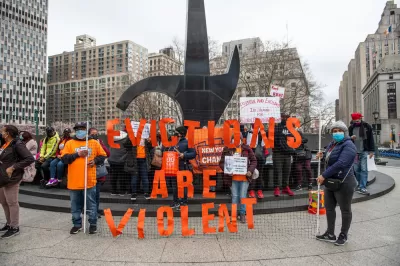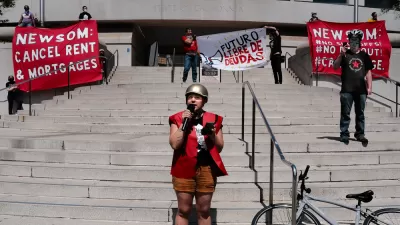Rental assistance spending in June surpassed the entire year's total so far, but there's still a long way to go.

"Emergency rental relief reached far more tenants and landlords in June than in previous months, reflecting delayed progress as the Biden administration, states and cities attempt to stave off an eviction crisis later this summer," reports Rachel Siegel.
As much money was paid to households in need of assistance in June as January through May combined, according to Siegel. Despite the progress, the pace of relief is slow relative to the amount of money available to support households through the economic consequences of the pandemic:
But housing experts caution there is a long way to go. Only about $3 billion was spent on rent, utilities and arrears through June — just a fraction of the $46 billion, in total, Congress appropriated for emergency rental aid. The vast majority of the money has not been spent while states and cities struggle to prop up programs that get money out the door.
Diane Yentel, president and chief executive of the National Low Income Housing Coalition, is quoted in the article noting that many states and cities have yet to provide any assistance to renters in need.
Indeed, Treasury data released Wednesday shows spotty progress. Some states saw encouraging jumps — the state of Illinois went from reporting zero assistance in the first five months of the year to $95.4 million in June, in large part because state officials took so long to build the program. California’s spending more than doubled in June to $74.4 million, up from $30.2 million in May.
Other places continued to lag behind or didn’t see major increases in spending, according to the Treasury data. Idaho paid out $1 million in rental assistance in May, and $1.1 million in June. Nevada paid out $2.6 million in May, then paid out less — $700,000 — in June.
For details about why some states have suddenly ramped up spending, click through to the source article.
For more reading on how to speed up rental assistance programs, see a recent article that listed three ideas to accomplish that goal.
FULL STORY: Rental relief programs ramped up in June, but fears mount that momentum may be coming too late

Planetizen Federal Action Tracker
A weekly monitor of how Trump’s orders and actions are impacting planners and planning in America.

Congressman Proposes Bill to Rename DC Metro “Trump Train”
The Make Autorail Great Again Act would withhold federal funding to the system until the Washington Metropolitan Area Transit Authority (WMATA), rebrands as the Washington Metropolitan Authority for Greater Access (WMAGA).

DARTSpace Platform Streamlines Dallas TOD Application Process
The Dallas transit agency hopes a shorter permitting timeline will boost transit-oriented development around rail stations.

Supreme Court Ruling in Pipeline Case Guts Federal Environmental Law
The decision limits the scope of a federal law that mandates extensive environmental impact reviews of energy, infrastructure, and transportation projects.

Texas State Bills to Defund Dallas Transit Die
DART would have seen a 30% service cut, $230M annual losses had the bills survived.

Bikeshare for the Win: Team Pedals to London Cricket Match, Beats Rivals Stuck in Traffic
While their opponents sat in gridlock, England's national cricket team hopped Lime bikes, riding to a 3-0 victory.
Urban Design for Planners 1: Software Tools
This six-course series explores essential urban design concepts using open source software and equips planners with the tools they need to participate fully in the urban design process.
Planning for Universal Design
Learn the tools for implementing Universal Design in planning regulations.
Roanoke Valley-Alleghany Regional Commission
City of Mt Shasta
City of Camden Redevelopment Agency
City of Astoria
Transportation Research & Education Center (TREC) at Portland State University
US High Speed Rail Association
City of Camden Redevelopment Agency
Municipality of Princeton (NJ)




























